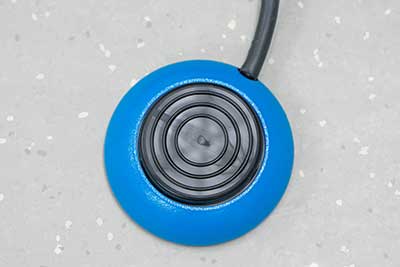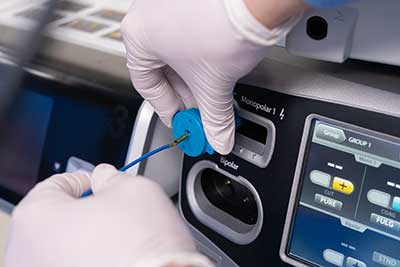Preparation for Electrosurgery: A Review of the Electrosurgical Unit
By: Emily McKisson, MS, BSN, RN, CNOR
Published: 7/18/2024
Most surgeries today involve using an electrosurgical unit (ESU), also known as the Bovie machine, to cut and cauterize tissue. The ESU consists of an electrosurgical generator with connections for a foot pedal, handpiece, and dispersive electrode (ie, grounding pad, Bovie pad). The generator produces an electric current that heats and damages the tissue at the surgical site, allowing the surgeon to incise the tissue while controlling bleeding. In monopolar electrosurgery, the active electrode is at the surgical site and the return electrode is placed elsewhere on the patient's body via the grounding pad. In bipolar mode, both the active and return electrodes are at the surgical site via the two separate tips of the bipolar forceps. The RN circulator should prepare for the use of electrosurgery by having the appropriate attachments (eg, handpiece, grounding pad, foot pedals) ready to use with the ESU and by verifying that the cut and coagulation settings on the machine correspond with those specified on the surgeon’s preference card.1,2
Hand or Foot Control
When setting up your OR for a surgical procedure, it is important to consider how the surgeon intends to control the ESU. Hand control is the most common method used in open cases across various surgical specialties. For minimally invasive procedures, surgeons may prefer foot control, which requires two additional pieces of equipment: the foot-pedal attachment with cut and coagulation options and a special adapter piece that connects to the ESU.
Foot Pedals
The ESU may be equipped with two foot-pedal attachments: one for using monopolar energy and another for bipolar energy. The main distinction between the two is that the monopolar foot-pedal attachment has two sides with a pedal on each side (Figure 1). One pedal is used for cutting and the other is used for coagulating. These foot pedals may vary in color and style depending on the manufacturer, but the dual-pedal energy selection is universal. Bipolar foot-pedal attachments, on the other hand, have only one option for activation and therefore only one pedal (Figure 2).
A helpful tip is to attach the foot pedal to the ESU machine and then position it under the head of the OR bed while the room and equipment are being set up prior to the case starting. After the patient is anesthetized and draped, the RN circulator can easily move the pedal by the feet of the surgeon who will be using the corresponding handpiece.

Figure 1. Monopolar foot-pedal attachment: one pedal is used to cut and the other is used to coagulate.

Figure 2. Bipolar foot-pedal attachment: only one option for activation and therefore only one pedal.
Adapter for Foot Control
If the surgeon plans to use a foot pedal to operate a monopolar ESU handpiece, an adapter may be required (Figure 3). The adapter itself has a small opening that accepts a cord passed from the sterile field that is necessary for foot control. Unfortunately, the adapter is one of the most difficult items to locate in the OR because it is used so infrequently, which often results in it being lost or inadvertently discarded. A surgeon will need the adapter for foot control during laparoscopic procedures, such as a laparoscopic cholecystectomy. In these instances, the surgeon attaches an ESU cord to the handle of a laparoscopic instrument. The ESU cord will then be passed off the surgical field and connected to the ESU machine through the opening of the adapter. The adapter creates a path of energy from the ESU machine to the laparoscopic instrument. When the instrument is inside the body cavity, the energy from the ESU machine is then activated by the surgeon when they step down on their foot pedal.

Figure 3. Adaptor for foot-pedal use.
Grounding Pad Placement
When using monopolar energy, regardless of whether the ESU is controlled by hand or foot, it is essential to provide a return path for the electric current by appropriately placing a grounding pad on the patient. Deciding where to place the grounding pad is another crucial point for the circulator to consider. To avoid patient injury, the grounding pad should not be placed over or near metal implants, which can increase the flow of electric current and cause burns. During the preoperative interview, the circulator should ask the patient if they have any implants. It also is helpful to review the patient’s previous surgical history for any orthopedic procedures involving metal implants. These cases should raise red flags and be discussed during the preoperative patient interview to determine the type of procedure and the specific implant in place.
Procedures that often involve metal Implants include
- total shoulder, hip, and knee replacements;
- orthopedic trauma cases, such as open reduction internal fixations (ORIFs) of the ankle, femur, pelvis, or wrist; and
- spinal cases during which hardware is implanted (eg, spinal fusions).
Editor's note: AORN does not endorse any commercial company’s products or services. Inclusion or exclusion of products in this article does not constitute an endorsement or review (implied or otherwise) by AORN of the quality or value of such product, or of the claims made by its manufacturer.
References
- Electrosurgical device. Accessed March 14, 2024. https://www.sciencedirect.com/topics/nursing-and-health-professions/electrosurgical-device
- Cordero I. Electrosurgical units – how they work and how to use them safely. Community Eye Health. 2015;28(89):15-16.
AORN Resources
AORN members can access:
Electrosurgical Safety: Guideline Essentials | AORN
Electrosurgical Safety: Clinical FAQs | AORN
Best practices for reporting electrosurgical unit malfunctions - AORN Journal
Guidelines in Practice: Electrosurgical Safety - AORN Journal
Guideline Quick View: Electrosurgical Safety - AORN Journal

